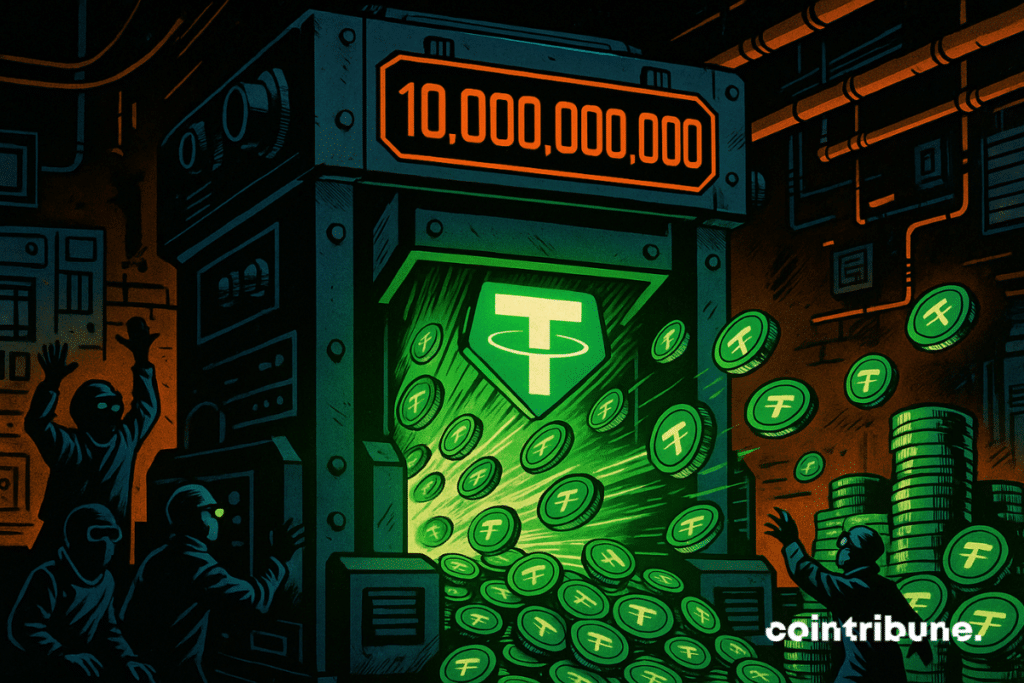Tether’s Massive Gains Spark Regulatory Questions
Tether has just crossed a dizzying threshold: more than 10 billion dollars in profit in just nine months. Behind this extraordinary figure lies the rise of a key player in the crypto ecosystem. Issuer of the USDT, the most used stablecoin in the world, Tether impresses as much as it raises questions. This record profitability, revealed in its latest attestation report, triggers as much enthusiasm as concerns, especially in terms of transparency and regulation.

In brief
- Tether generated over 10 billion dollars in profit in nine months, an unprecedented performance in the crypto sector.
- This exceptional profitability relies on massive exposure to U.S. Treasury bonds, estimated at $135 billion.
- The company also holds nearly 13 billion dollars in precious metals and 10 billion dollars in Bitcoin, illustrating a diversified investment strategy.
- Despite these results, Tether remains criticized for its lack of transparency, publishing attestations instead of full financial reports.
Tether : A record quarter driven by U.S. Treasury bonds
In the third quarter, Tether issued an additional 17 billion $ USDT, consolidating its status as the world’s leading stablecoin issuer.
While Tether forecasts a record profit of $15 billion in 2025, the company states it has crossed a symbolic milestone in its attestation published last Friday and certified by BDO : more than 10 billion dollars in cumulative profits during this year.
In July, Tether announced $5.7 billion in profits for the first two quarters. This implies that the third quarter alone generated at least $4.3 billion. “The results of Q3 2025 reflect continued confidence and strength around Tether, even in a challenging global macroeconomic environment“, stated Paolo Ardoino, CEO of Tether.
This spectacular growth mainly relies on the performance of its reserves. Here is what is known, according to official information :
- $135 billion exposure to U.S. Treasury bonds, significantly increasing, which ensures stable profitability thanks to the Fed’s current monetary policy ;
- $12.8 billion investment in precious metals, a diversification that strengthens reserve solidity ;
- $10 billion held in bitcoin, indicating a hybrid strategy between stable assets and cryptos ;
- A rapidly expanding distribution of USDT, with 17 billion $ of additional issuance in Q3, reflecting steady demand.
These figures confirm that Tether is now a central player in stablecoins, but also in digital capital markets.
Persistent opacity and the market’s divergent signals
Despite impressive figures, Tether’s very structure raises questions. As a private company registered in El Salvador, Tether does not publish full financial reports but quarterly attestations prepared by the firm BDO.
This lack of standardized accounting transparency prevents any independent verification of the details of its revenues or the precise management of its reserves. Moreover, while USDT remains the most used stablecoin, some indicators show that Tether’s dominance could be challenged. A recent analysis by JPMorgan highlights that Circle’s USDC stablecoin is now growing faster in terms of on-chain activity and capitalization.
This contrast is significant. While Tether announced it surpassed 500 million users in October, Bloomberg revealed in September that the company was in talks with investors to raise up to $20 billion, based on an estimated valuation of $500 billion. A colossal ambition, fueling both admiration and concern.
The lack of regulatory oversight, coupled with massive reserves concentrated in U.S. sovereign assets, fuels the debate on the role Tether now plays in the “shadow banking” of crypto.
It is therefore the limits of Tether’s model that raise concerns. Its current profitability largely depends on a favorable monetary context, notably the Fed’s high interest rates, but what will happen if these conditions reverse? Moreover, as Tether moves closer to a quasi-systemic role in the crypto market, expectations regarding governance, regulation, and transparency will only increase.
With over 10 billion dollars in profit, Tether, issuer of the USDT stablecoin, confirms its strategic weight in the crypto ecosystem. However, this success is accompanied by shadows. Transparency, regulation, and governance will be the key challenges in the coming months for a player that has become indispensable… and is now under increased scrutiny.
Maximize your Cointribune experience with our "Read to Earn" program! For every article you read, earn points and access exclusive rewards. Sign up now and start earning benefits.
Diplômé de Sciences Po Toulouse et titulaire d'une certification consultant blockchain délivrée par Alyra, j'ai rejoint l'aventure Cointribune en 2019. Convaincu du potentiel de la blockchain pour transformer de nombreux secteurs de l'économie, j'ai pris l'engagement de sensibiliser et d'informer le grand public sur cet écosystème en constante évolution. Mon objectif est de permettre à chacun de mieux comprendre la blockchain et de saisir les opportunités qu'elle offre. Je m'efforce chaque jour de fournir une analyse objective de l'actualité, de décrypter les tendances du marché, de relayer les dernières innovations technologiques et de mettre en perspective les enjeux économiques et sociétaux de cette révolution en marche.
The views, thoughts, and opinions expressed in this article belong solely to the author, and should not be taken as investment advice. Do your own research before taking any investment decisions.